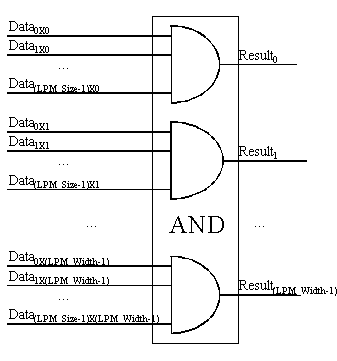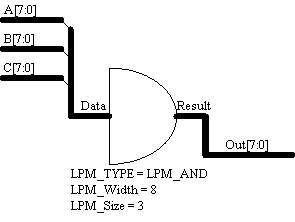![]()
Copyright © 1998 University of Manchester
|
|
|
4.2.3 LPM_AND |
|
Copyright © 1998 University of Manchester |

| Description | Comments | |||
| Data input | Vector, LPM_Size times LPM_Width wide | |||
| Result of AND operators | Vector, LPM_Width wide |
Properties
| Value | Comments | ||
| LPM Value > 0 | Width of output vector.
Number of AND gates. | ||
| LPM Value > 0 | Number of inputs to each AND gate.
Number of input buses. |
Where i goes from 0 to (LPM_Width - 1).
Suppose the designers have three 8-bit buses and they want to
AND the corresponding bits of the three buses. This is done using
an LPM_AND with an LPM_Width = 8 and an LPM_Size = 3. The LPM_Width
of eight indicates that there are eight AND gates, and the LPM_Size
of three indicates that each AND gate has three inputs.

The function performed by the LPM_AND gate in this case is:
Out[0] = Result0 = Data0X0 & Data1X0 & Data2X0 = C[0] & B[0] & A[0]
Out[1] = Result1 = Data0X1 & Data1X1 & Data2X1 = C[1] & B[1] & A[1]
Out[2] = Result2 = Data0X2 & Data1X2 & Data2X2 = C[2] & B[2] & A[2]
Out[3] = Result3 = Data0X3 & Data1X3 & Data2X3 = C[3] & B[3] & A[3]
Out[4] = Result4 = Data0X4 & Data1X4 & Data2X4 = C[4] & B[4] & A[4]
Out[5] = Result5 = Data0X5 & Data1X5 & Data2X5 = C[5] & B[5] & A[5]
Out[6] = Result6 = Data0X6 & Data1X6 & Data2X6 = C[6] & B[6] & A[6]
Out[7] = Result7 = Data0X7 & Data1X7 & Data2X7 = C[7] & B[7] & A[7]